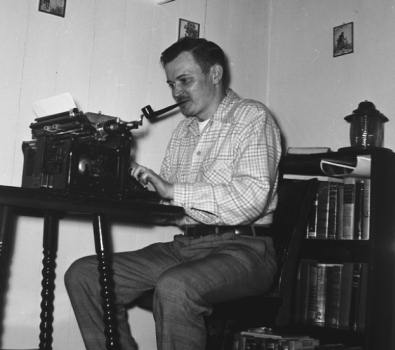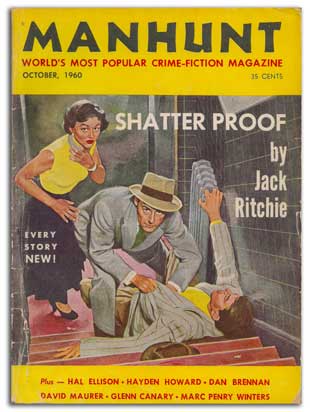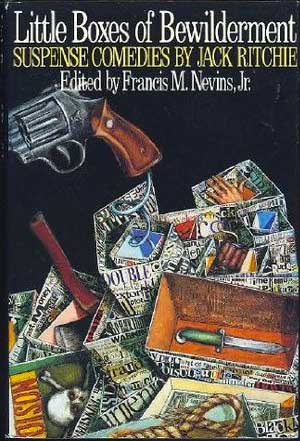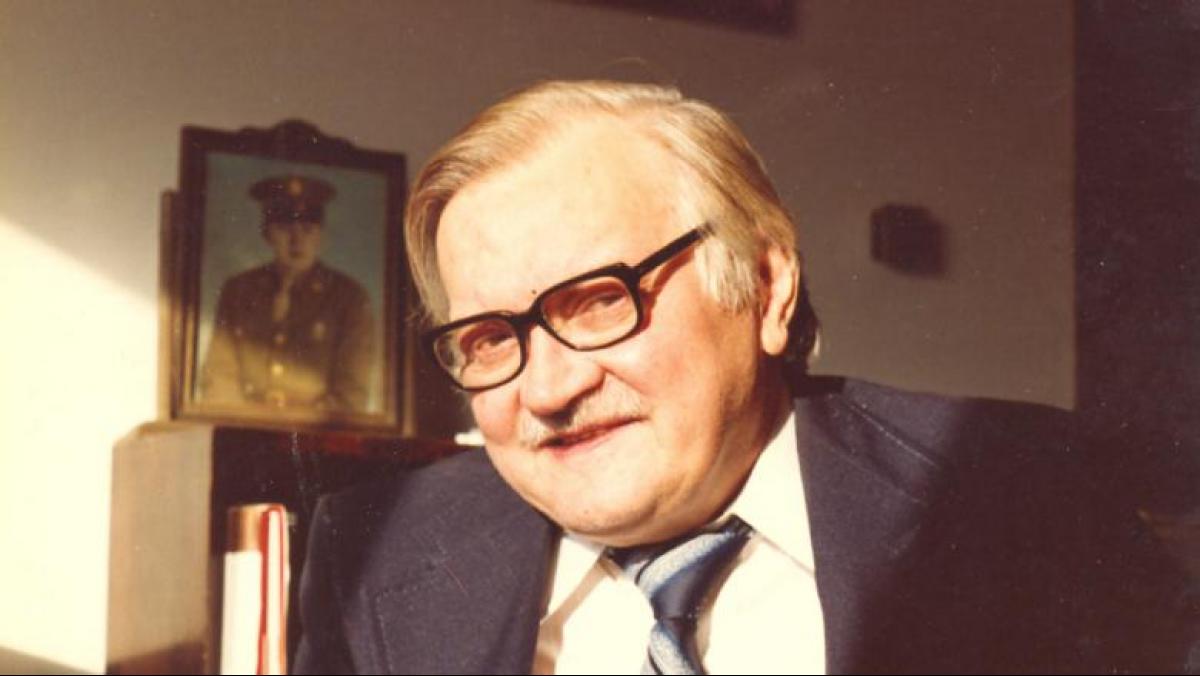Even though he is Wisconsin’s most productive writer of short stories, you might not know about Milwaukee-born author Jack Ritchie. A writer of hard-boiled crime fiction, Richie wrote nearly five hundred stories over his thirty-five-year career.
His writing features characters that rely on cunning and wit to get them out of difficult situations and a straightforward style that eschews elaborate description for narrative tension. In a nod to O. Henry, another prolific writer of short stories, Ritchie often ends his tales of murder and mayhem not with one surprise but two—and even, on occasion, three.
Born John George Reitci (February 26, 1922), Ritchie did not assume his pen name until he began his writing career in his early thirties. His father was a tailor in Milwaukee; his mother, a housewife. Following graduation from high school, he attended Milwaukee State Teachers College (now University of Wisconsin–Milwaukee) for a time.
When World War II came along. Richie enlisted and spent three and a half years in the Army, mostly in the Pacific. It was on the island of Kwajalein that a bored Ritchie, desperate for reading material, began devouring the mystery novels of Raymond Chandler, Agatha Christie, and John D. MacDonald.
While he soon became addicted to the mystery genre, Richie was not yet writing his own stories. After an honorable discharge from the Army, Ritchie tried school again under the GI Bill, but gave it over to work with his father in tailoring—a temporary arrangement, he hoped.
Inspired by his mother, who had recently joined a writer’s group in Milwaukee and harbored her own dreams of literary recognition, Ritchie tried his hand at a few stories, mainly about sports. When literary agent Larry Sternig dropped by to talk to his mother, Ritchie handed him a recently composed sports story. The next day Sternig called Ritchie and encouraged him to continue writing.
Ritchie decided to write fifty stories in a year and see if any sold. His eighth attempt connected. Sternig, who became Ritchie’s longtime friend and agent, sold his first story to the New York Daily News for $50. “Always the Season” was published on December 29, 1953, marking the beginning of a long and fruitful career.
His earliest stories—sports, romance, science fiction—appeared during the 1950s in such diverse publications as the Philadelphia Inquirer, Smashing Detective Stories, and Good Housekeeping. He soon found his niche and his first major publisher in Manhunt Detective Stories Monthly, which was based in New York City. The world’s best-selling crime fiction magazine, Manhunt seemed a perfect match for Ritchie, eventually printing 23 of his stories—the most enduring of them, “Shatterproof.”
At a time of waning popularity for the short story, Manhunt was one of the few magazines that featured only short mystery and crime stories. Ritchie had no trouble adapting his developing talent to the newly popular genres. When Alfred Hitchcock started his own Mystery Magazine in 1956, Ritchie, along with fellow Wisconsinite Robert Bloch of Psycho fame, began appearing in that magazine as well. Both often had stories in the same issue.

Soon Ritchie’s stories were cropping up in Hitchcock’s monthly Mystery Magazine four or five times a year, then six, then nine, and, finally in 1961, thirteen times (he had two in one issue). From 1957 to 1982 well over a hundred of Ritchie’s stories, as well as eight under the pen name Steve O’Connell, appeared in the magazine, and there were few Hitchcock anthologies during those years that did not include at least one of Ritchie’s (and one of Bloch’s) stories.
At least three Ritchie stories were adapted for the TV series, Alfred Hitchcock Presents, which ran from 1955 to 1962. When Ellery Queen’s Mystery Magazine started in 1976, Ritchie wrote for that as well, appearing in its pages at least thirty times.
Ritchie’s early stories were short in length, terse in style, and murderous in subject matter. He never wasted a word. From the first sentence, “He was a soft-faced man wearing rimless glasses, but he handled the automatic with unmistakable confidence” (from “Shatterproof”), to the last comment—sometimes a single word, never more than a sentence—Ritchie wrung every last drop of dark humor and pathos from sometimes as few as 1,000 words. (He once said that had he written Victor Hugo’s Les Misérables, the 30,000-word section on the sewers of Paris would have come out as a paragraph or two.)
A number of his stories feature familiar Wisconsin streets, highways, and locations, particularly around Milwaukee. The Milwaukee Lakefront, Lake Shore Drive, and even the pedestrian bridge down from the East Side serve as backdrops for burglary, larceny, and murder. Capitol Drive appears frequently in Ritchie’s early stories, and Third and Wisconsin, Wells, 68th Street, and the 27th Street and 35th Street viaducts figure in others. County General Hospital, variously named suburbs, an outstate community or two, and even Taycheedah prison for women are mentioned. In a sly homage to his home state, nearly all of the drinks served to or by his characters contain brandy.
A Ritchie story provides little description and relies heavily on exposition through dialogue punctuated with wry commentary from a narrator who could be a convict or a con artist, a warden or a blackmailer, a murderer or a fraud, a private eye or a detective, a victim or an innocent bystander. And at the end, the expectations of the reader are often flummoxed through a neat twist or two that surprise, but never disappoint.
In “The Customer” (Mike Shayne’s Mystery Magazine, March 1983), a middle-aged man sits down at a table at the country club and begins a conversation with a man he has been told is a contract killer. Fearing entrapment, the narrator of the story, whom we learn is indeed a contract killer, proceeds with caution. Eventually he lets down his guard, and the two come to terms. When the second man pushes a small wrapped package toward the narrator and identifies himself as Lieutenant Walter Morgan of the police department, it seems the killer’s worst fears have been realized. But, in another twist, we learn Morgan is earnest about having his wife murdered.
The two agree on the time and place to provide an alibi for Morgan, and the killer accepts the $5,000—less than his usual fee, but adequate—to seal the deal. Twist number three comes when the killer realizes that the Lieutenant knows too much and that he—rather than his wife—needs to disappear.
Lest the reader think these stories are glum, there is plenty of humor amidst the homicide. Some suggest that Ritchie may have picked up his streak of dark humor from friend and fellow Wisconsin mystery writer Craig Rice. Known as “the Dorothy Parker of detective fiction,” Rice penned dozens of detective stories and novels that incorporated sometimes witty and sometimes screwball comedic elements.
This comedic touch is found in “The Violet Business” (Alfred Hitchcock’s Mystery Magazine, September 1971) when the agents for a particular killer contact him by running an ad in the paper about a lost black and white collie answering to the name Violet. The client, a man named Lynch, wants himself killed, shot through the heart: “A wise choice,” the narrator responds, “and neat. Most people prefer the open coffin viewing.”
Lynch has decided that the best thing he can do for his wife and two children is to die so they can collect on his large insurance policy. The killer accepts the $5,000 down payment, but his suspicions have been aroused. He goes early to the distant town, books a room, and discovers two things: Lynch is unmarried and he is running for DA. The whole thing smells of a setup.
Returning to his hotel room without carrying out his contract, the killer finds the local chief of police already there with some damning evidence in one hand and a police revolver in the other. But what charge could be made? Murder? He didn’t kill Lynch. It is only then that the reader learns our hired killer has never killed anyone. Rather, he plays the murder-for-hire game, collects the money, and then warns the interested parties.
“In short, we saved lives, and made a rather nice profit doing so,” the narrator informs us. The police chief, of course, does not know what we know. It seems that the arrest of this “murderer” is inevitable when the story takes another twist as the chief negotiates the murder of his own wife for $4,000 in cash, leaving the narrator to decide if he will become the murderer he has always claimed to be or go to jail.
It is this sort of forthright indirection (or hidden misdirection) that is a Ritchie trademark: the reader is led along by a somewhat neutral narrator through a perfectly logical series of events only to face a complication or two that force a re-interpretation of both plot and character.
Things are never what they seem in a Ritchie story, and the array of flim-flam artistry is incredible. Just as often as not, the con artist is the one who gets conned in Ritchie’s world, forcing the characters to exercise all their cunning in an effort to extricate themselves from a situation—or even to save their lives. And running under it all is a keen satirical wit, making fun of murder, yes, but also of academics, artists, country club members, lawyers, judges, politicians, and other social elites.
Perhaps Ritchie’s most famous story is “The Green Heart” (Alfred Hitchcock’s Mystery Magazine, March 1963), which was adapted for the cinema as A New Leaf, starring Elaine May and Walter Matthau. The short story, which can be read in twenty minutes, takes almost two hours to unravel on the big screen. It begins with this beauty of brevity: “We had been married three months and I rather thought it was time to get rid of my wife.”
The 45-year-old, ne’er-do-well narrator, William Graham (Matthau in the movie), has wooed and wed an ingenuous, klutzy, and unstylishly dressed professor Henrietta Lowell (Elaine May), who just happens to be rich. While she talks with him about their annual trip to the Northwoods to find specimens for her botany research, he is running over in his mind the various methods and opportunities to do her in. In the meantime, Graham fires a number of servants who were on the take at the house, and serves poisoned scotch to a black-mailer who has taken advantage of his naïve wife’s generosity. “That confirmed a suspicion of mine,” coolly notes Graham. “People who drink Scotch have no sense of taste.”
On their honeymoon Lowell had found what she suspects is a new plant species and names it for him: Alsophila grahamicus. Just before the subsequent Northwoods trip, Lowell receives confirmation of the classification and presents Graham with a piece of the fern encased in plastic. He is pleased, but undeterred from planning her demise even after he is forced to kill yet another interloper—with the leftover poisoned Scotch.
On their first day in the Northwoods, Graham and Lowell canoe down a river and run into heavy rapids. He is, of course, inexperienced, and their canoe capsizes. Though he makes it to shore, Lowell clings to rock in the middle of the rapids. He shouts directions to her, only to learn that she can’t swim. After all his plotting, how easy this is going to be, he reflects. Graham tells her to slip into the current, and he will catch her as she comes down. She lets go, and as he turns his back to the river and her likely demise his attention is attracted by the plastic-encased Alsophila grahamicus, which has fallen from his pocket. It strikes him how total her trust in him really is. Perhaps he feels something for her as he turns about, plunges into the water, and saves her life.
 Romantic? Humorous? Psychotic? “The Green Heart” is a masterpiece of ingenious, entertaining writing. On the heels of the movie’s release, Ritchie published his first collection of short stories. A New Leaf and Other Stories drew on the notoriety of the film, but there were seventeen other marvelous tales, all but two culled from Hitchcock’s magazine. One story, “Shatterproof” (Manhunt, October 1960), might be the best Ritchie ever wrote.
Romantic? Humorous? Psychotic? “The Green Heart” is a masterpiece of ingenious, entertaining writing. On the heels of the movie’s release, Ritchie published his first collection of short stories. A New Leaf and Other Stories drew on the notoriety of the film, but there were seventeen other marvelous tales, all but two culled from Hitchcock’s magazine. One story, “Shatterproof” (Manhunt, October 1960), might be the best Ritchie ever wrote.
“Shatterproof” begins with a wealthy middle-aged man finding himself at the wrong end of a gun. The rich man learns that his young wife, impatient for his money (all of it), has hired a contract killer. The rich man obligingly fixes drinks for his guest and himself, then sits across from the killer. Inveigling the killer twice to look away for a moment, the narrator then stands, takes a glass from the table, and locks it within his safe.
The killer is puzzled at the action at first, then dismayed as he is forced to question whether the glass locked in the safe is the rich man’s or his own—with his fingerprints on it. Exploiting the killer’s doubt, the narrator uses the leverage of the incriminating glass to renegotiate his death contract. Only after the killer leaves to murder the rich man’s wife do we learn that the glass in the safe actually belongs to the narrator. It was all a bluff of magnificent chutzpah.
In its dialogue, sardonic commentary, deception, and cold-bloodedness, “Shatterproof” ranks with Edgar Allen Poe’s “The Cask of Amontillado.” Poe’s story ran to about 1,600 words; Ritchie’s, about the same. It was just such expertise that prompted mystery writer and critic, Anthony Boucher, to write:
What I like most about Jack Ritchie’s work is its exemplary neatness. No word is wasted, and many words serve more than one purpose. Exposition disappears; all needed facts are deftly inserted as the narrative flows forward. Ritchie can write a long short story that is virtually the equivalent of a full suspense novel; and his very short stories sparkle as lapidary art.
A later story, “Absence of Emily” (Ellery Queen’s Mystery Magazine, January 1981), is a Ritchie tour de force. Everything points to the narrator, Albert, having done away with his short, too plump wife, Emily. A widower whose previous wife died in a boating accident, Albert appears anxious when asked by friends and family where Emily has gone. Meanwhile, Emily’s rich and overbearing cousin Millicent takes it upon herself to discover her whereabouts. When she sneaks into their home and finds Emily’s closet full of clothes and luggage, Millicent begins a systematic campaign to entrap her “poor cousin’s” murderous husband.
Unbeknownst to Millicent (and the reader) Albert is carefully cultivating an aura of suspicion. He takes a shovel to the back of the estate and begins to exhume something under cover of darkness only to be immediately surrounded by a group of hired detectives and cousin Millicent. Millicent orders the detectives to excavate the area in search of Emily’s corpse, but they find nothing. An innocent Albert threatens to sue, but says he will forego such public embarrassment for some financial consideration—and Millicent agrees to a large consideration. A week later and thirty pounds lighter, Emily emerges from a month-long stay at a health farm. She didn’t want her nosy cousin to know about the trip, and had instructed Albert to get rid of her old clothes, a task he spun into a web of deceit that eventually yielded a financial windfall. With Millicent’s “consideration” in hand, Albert assures Emily that she can now replace her entire wardrobe.
“Absence of Emily” is a gem of a story, reflecting the author’s multifacted writing talents. The same year it appeared in Ellery Queen’s Mystery Magazine, the story was included in The Year’s Best Mystery and Suspense Stories (Dutton, 1983). At the Mystery Writers of America annual meeting Ritchie’s story won the prestigious Edgar Award—a small bust of Edgar Allen Poe—for the best short suspense story of the year. It was a high point in Ritchie’s career.
In the meantime his personal life was undergoing change. He and his wife, fellow writer, Rita Reitcie, divorced after twenty years of marriage. Alone now, he settled into an apartment in Fort Atkinson and continued to churn out classic Ritchie stories, most destined for the Hitchcock’s and Ellery Queen’s magazines.
Then in April, 1983, he suffered a heart attack and died at the age of 61. Even after his death, Ritchie’s stories continued to appear in the magazines and in various collections. Mystery writer Lawrence Block was one among many who patiently waited for every Ritchie story, whether new or reprint. “His work was sprightly and surprising and always engaging,” Block wrote in an article in American Heritage magazine, “and he never wrote an awkward sentence or a lifeless line of dialogue.”
Four years after Ritchie’s death, Southern Illinois University Press published The Adventures of Henry Turnbuckle (1987), thirty stories involving the titular character, most published in the last six years of Ritchie’s life and three posthumously. Henry Turnbuckle began the series as a Milwaukee patrolman who unfortunately for his career had arrested the mayor’s son for drunken driving. Despite this setback, Turnbuckle works his way up to detective sergeant on the city’s police force, homicide division.
The humor in the stories comes from the elaborate theories Turnbuckle develops to explain seemingly random pieces of evidence, some as inconsequential as a cigarette butt or a toothpick. There is always some discrepancy or something outrageous in the conclusions he draws, which are generally wrong. Frustrated, Turnbuckle takes a glass of sherry, then, perhaps after another such elaboration or two, stumbles into the solution of the case.
The whole series is really an elaborate send-up of formulaic mystery stories, from the locked room puzzle to the hard-boiled private eye. “Suspicion is my business,” Turnbuckle points out, whether as shamus or sergeant. Eventually Ritchie gives him a partner, Ralph, who is continually amazed and frustrated at the “detecting abilities” of his sergeant, commenting, “Henry, you can get more out of less than anybody I know.”
 The Turnbuckle stories were very popular, appearing primarily Hitchcock’s and Ellery Queen’s magazines. At the same time, as if anticipating today’s obsession with the undead, Ritchie’s Count Cardula stories began to appear. A vampire-turned-private eye, Cardula (his name an anagram for Dracula) works only at night. Ritchie has fun with little touches, such as Cardula needing to work to pay off the debt on his mansion along the lake, the unusual working hours from sunset to sunrise, and his odd sleeping arrangements. But Cardula is just as astute as some of Ritchie’s other characters. Only a handful of the stories, however, were completed before his death.
The Turnbuckle stories were very popular, appearing primarily Hitchcock’s and Ellery Queen’s magazines. At the same time, as if anticipating today’s obsession with the undead, Ritchie’s Count Cardula stories began to appear. A vampire-turned-private eye, Cardula (his name an anagram for Dracula) works only at night. Ritchie has fun with little touches, such as Cardula needing to work to pay off the debt on his mansion along the lake, the unusual working hours from sunset to sunrise, and his odd sleeping arrangements. But Cardula is just as astute as some of Ritchie’s other characters. Only a handful of the stories, however, were completed before his death.
In 1989 St. Martin’s Press brought out Little Boxes of Bewilderment, a collection of thirty short mysteries by Ritchie, some of which had appeared earlier in A New Leaf. Francis M. Nevins, the same editor who assembled the Henry Tumbuckle stories, brought these together as well. In the extensive introduction to the collection. Nevins characterizes Ritchie’s wonderful narratives:
More and more often he’d cook up one of his corkscrew plots, add black humor and an unmistakably personal narrative voice, get it down on paper with a bare minimum of words, and end up with a story inimitably his own.
That is praise indeed, providing a fitting epitaph for a remarkable writer and Wisconsin native, Jack Ritchie. But no amount of description, criticism, or summary is adequate for Ritchie. There is no substitute for the hands on experience of his unique style of storytelling. These stories must be read and savored by the individual reader in order to understand how Ritchie’s prose is truly shatterproof.




